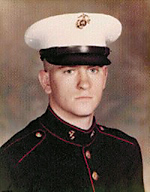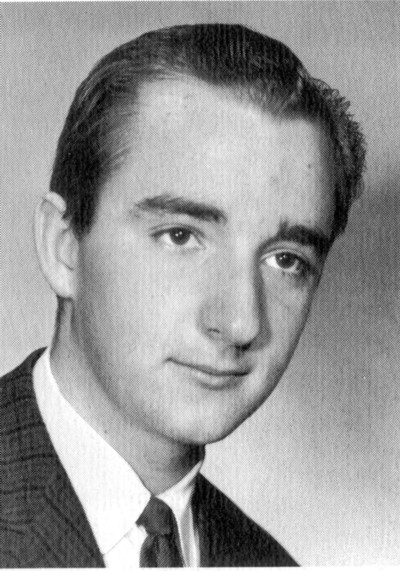
THOMAS L BLEVINS - CPL
- HOMETOWN:
- middletown
- COUNTY:
- Monmouth
- DATE OF BIRTH:
- April 12, 1948
- DATE OF CASUALTY:
- May 31, 1969
- BRANCH OF SERVICE:
- Marines
- RANK:
- CPL
- STATUS:
- KIA
- COUNTRY:
- South Vietnam
Biography
Thomas L. Blevins, Jr. was born on April 12, 1948, to Thomas and Cora Blevins. His home of record is Middletown, NJ. Thomas had a younger brother, Rodney. He graduated from Middletown High School in 1966. In high school he participated in football and wrestling. After high school, he attended Rutgers University for two years.
Blevins enlisted in the US Marine Corps. He became the leader of Company C, 1st Battalion, 26th Marines, 9th Marine Brigade. He attained the rank of Corporal (CPL).
Blevins was killed in action in South Vietnam on May 31, 1969. His squad came under enemy fire and he administered first aid to three of his wounded men. He then ran back and hurled a hand grenade to distract the enemy, but was mortally wounded by small arms fire. He was awarded the Navy Cross.
His body was returned to Middletown, NJ, and he is buried in Fairview Cemetery.
Tom's photo and some medals are mounted on the Wall of Remembrance at Middletown High School North. Staring in April 2009, the school will award the Tom Belvins Award to an outstanding high school senior who demonstrates courage, leadership, character and team before self.
Thomas Blevins, Jr.'s Navy Cross citation reads:
For extraordinary heroism while serving as a Squad Leader with Company "C", First Battalion, Twenty - Sixth Marines, Ninth Marine Amphibious Brigade in connection with combat operations against the enemy in the Republic of Vietnam. On 31 May 1969, while Corporal Blevins maneuvered his squad as the point element of a company - sized search and destroy operation in Quang Nam Province, the Marines came under a heavy volume of automatic weapons fire from a large enemy force occupying well - concealed, fortified emplacements. Observing that three of his men had been wounded and had fallen in an unprotected area close to the hostile positions, Corporal Blevins unhesitatingly left his relatively secure position and ran across the fire - swept terrain to the side of his companions. After kneeling in a dangerously exposed position to administer first aid to one of his comrades, he removed the man to waiting medical attention behind the friendly line. He then again braved the hostile fire raking the area and, after administering brief emergency treatment to the second wounded Marine, moved him back to the company's defensive perimeter. When he raced to the aid of the third man, they both became pinned down by concentrated enemy fire. Corporal Blevins, in full view of the enemy troops, hurled a hand grenade which diverted their attention sufficiently to allow him time to move the injured Marine to safety, but before he could attain a covered position himself, he was mortally wounded by small - arms fire. His heroic efforts and selfless concern for his fellow men inspired all who observed him and were instrumental in saving the lives of three Marines. By his courage, aggressive fighting spirit and unwavering devotion to duty, Corporal Blevins upheld the highest traditions of the United States Marine Corps and the United States Naval Service.
I served with Cpt. Tom Blevins in Vietnam. I was a member of 3rd squad which was led by Chase the Bear (Native American, Cheyenne) and did not know him personally, but was right next to him as he faded away following his heroic acts.
My brother Steven Hellwig was killed in action at Khe Sanh on January 21, 1968, when that combat base came under heavy attack from NVA regulars. It was NVA regulars who ambushed us (Charlie Co. 1/26) on May 31, 1969.
It was during our first week of Operation Pipestone Canyon in the area of Go Noi Island (what was referred to as Arizona Territory/Dodge City). First Platoon Charlie Co. was maneuvering left along side the old railroad berm in the area when it came under machine gun and other small arms fire. Cpl. Blevins and his squad (1st or 2nd squad [I don't remember for sure]) were right in the middle of it all. As part of 3rd squad I was on ground just a little higher in elevation than that which was occupied by 1st and 2nd squad. The land sloped down slightly before coming up to the old railroad berm itself.
As the NVA opened up on us, I jumped into an old bomb crater along with one other Marine. I was a PFC and new in-country, my second operation after Daring Rebel. (Our operations were staged from the USS Iwo Jima at this time, our helicopter squadron was HMM-265). Portions of 1st Platoon were actually on top of the berm as we maneuvered left and those Marines sustained fire from the opposite side of the berm - there were NVA located in spider-holes on the berm itself who were firing on elements of our platoon moving right along side it to the left. I immediately began laying down fire next to the spider hole where the automatic fire was; I needed to be careful of our own troops. This was not hard. We were trained well and I was accurate with my M-16, and it was my job to try and suppress enemy fire (I was only 18 years old, but I was confident).
After considerable time and action, we sustained several casualties. Marines in front of me moved to rescue each other with amazing heroism. After Cpl. Blevins was hit during his rescue activities, he was drug into the bomb crater I was firing from. I looked over at him several times between firing (the fire-fight was continuing) as he was lying on his back. I thought we should put him on his side, the side he was hit on. In first aid we were trained to put the Marine on the side of a sucking chest wound (when a round is taken to the lung) to keep blood from running to the other lung. The Corpsman told me that Cpl. Blevins had sustained a double sucking chest wound (each lung had been hit) and it would not help to put him on his side.
Cpl Blevins was breathing softly. He was not sweating and his skin was dry even though it was very hot out. Clearly, he was dying. Although the fire-fight continued, in fractions of a second I thought of my brother Steven, then of my family, then I thought about the terrible news Cpl Blevins' family would be receiving in a day or so. I knew Blevins was fading away and would die.
Operation Pipestone Canyon was very tough for Charlie Company. The operation continued after this day, and we were hit almost every night. The second to the last night (June 7, 1969) was the toughest, there was substantial incoming and hand to hand combat with NVA Sapper units, we lost several Marines, 9 were KIA that night. The next day I was providing perimeter security as a CH-53 came in for the KIAs. I watched as Marines carried those KIA onto the chopper, again I thought about my brother, my family, and then the families of the Marines soon to be notified about their sons. It was a very tough time.
During the first 6 months of my tour, C. Co. 1/26 participated in 5 amphibious operations, the second one, Pipestone Canyon was the most difficult. I think about it every day. I think about my brother every day. But Cpl. Blevins - the image of his face is indelibly etched in my memory. He was a good Marine, a hero, a huge loss - and forever on my mind.
Written by Ray Hellwig, Veteran
Sources: Jack Cesar (volunteer), Ray Veth, Ray Hellwig (Vietnam Veteran), newspaper clippings and NJVVMF.
Remembrances
Be the first to add a remembrance for THOMAS L BLEVINS
Help preserve the legacy of this hero, learn about The Education Center.
LEARN MORE
